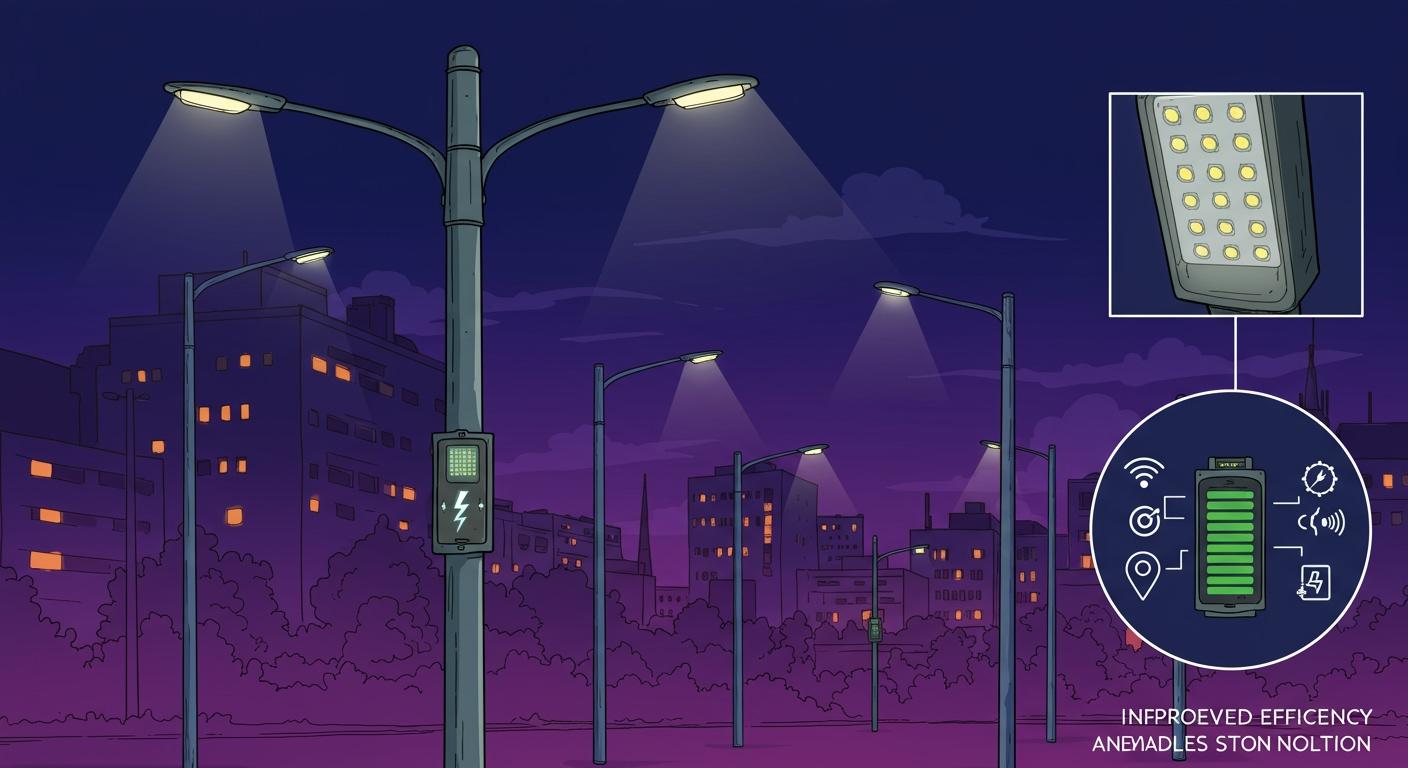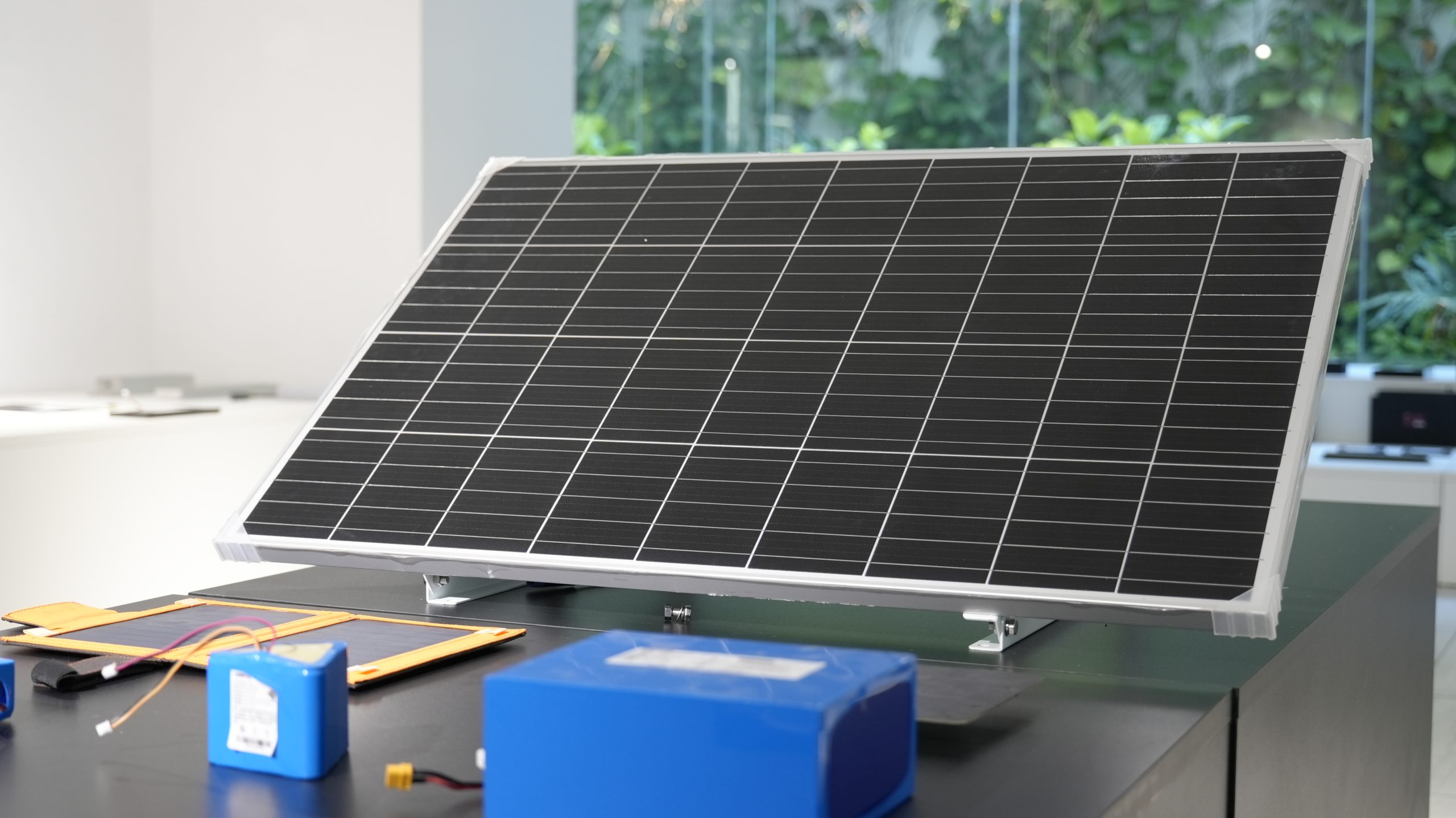
Smart batteries now drive autonomous and efficient LED street lighting across cities. You see a major shift from traditional batteries to advanced lithium technologies, such as LiFePO4, which offer improved energy management and reliability. Cities worldwide invest heavily in these solutions:
The lithium battery solar street light industry in China is valued at over $200 million, with rapid growth projected.
Exports from Yangzhou increased by 300% in just 10 months of 2024.
By 2027, lithium batteries are expected to power over 60% of solar street lights globally.
You benefit from technical, operational, and sustainability improvements as this trend continues.
Key Takeaways
Smart batteries, especially LiFePO4, offer higher energy density and longer lifespan than traditional batteries. This means fewer replacements and lower maintenance costs.
Using smart batteries improves energy efficiency, with charge/discharge rates of 90-97%. This reduces energy waste and keeps street lights bright and reliable.
LiFePO4 batteries are eco-friendly, using non-toxic materials and supporting solar energy. This helps reduce carbon emissions and promotes sustainability.
Solar street lights with smart batteries operate independently from the grid, ensuring reliable lighting even in remote areas. This enhances safety and security.
Investing in smart battery technology can lead to significant cost savings through lower energy consumption and reduced maintenance, benefiting both cities and businesses.
Smart Batteries: Technical Advantages

1.1 Energy Density & Lifespan
You gain a significant advantage when you choose smart batteries for LED street lighting. Lithium battery packs, especially LiFePO4, deliver much higher energy density compared to traditional lead-acid batteries. This means you get more energy storage in a smaller, lighter package.
Battery Type | Energy Density (Wh/kg) |
|---|---|
LiFePO4 | 90-160 |
Lead-acid | 30-50 |
LiFePO4 batteries can reach energy densities up to 620 Wh/kg, far surpassing the 30 to 50 Wh/kg typical of lead-acid batteries. This high efficiency allows you to install compact systems that deliver reliable lighting for longer periods.
When you look at lifespan, lithium batteries stand out. LiFePO4 batteries last between 8-10 years and handle up to 5000 charge cycles. In contrast, lead-acid batteries usually last only 2-3 years. You benefit from a longer lifespan, which means fewer replacements and lower maintenance costs.
To help you compare lithium battery chemistries, here is a table showing platform voltage, energy density, and cycle life. These values are standardized for B2B applications in medical, robotics, security, infrastructure, consumer electronics, and industrial sectors.
Chemistry | Platform Voltage (V) | Energy Density (Wh/kg) | Cycle Life (cycles) | Application Scenarios |
|---|---|---|---|---|
LiFePO4 | 3.2 | 90-160 | 2000-5000 | Infrastructure, Industrial |
NMC | 3.7 | 150-220 | 1000-2000 | Medical, Robotics, Security |
LCO | 3.7 | 150-200 | 500-1000 | Consumer Electronics |
LMO | 3.7 | 100-150 | 300-700 | Consumer Electronics |
LTO | 2.4 | 70-80 | 7000-20000 | Industrial, Medical |
Solid-state | 3.7-4.2 | 250-500 | 2000-10000 | Medical, Security |
Lithium Metal | 3.7-4.2 | 350-500 | 1000-2000 | Robotics, Security |
You can find more technical details about lithium battery performance in Nature and Science.
1.2 Charge/Discharge Efficiency
Smart batteries deliver transformative performance advantages in LED street lighting. Lithium battery packs achieve a charge and discharge efficiency of 90-97%. Lead-acid batteries only reach about 80%. You lose less energy during charging and discharging, which means your system operates with high efficiency and lower energy waste.
Lithium-ion batteries: 90-95% charge/discharge efficiency
Lead-acid batteries: 80% charge/discharge efficiency
This high efficiency ensures your street lights stay bright and reliable, even during extended periods of use. You maximize energy utilization and minimize operational costs.
1.3 Temperature & Safety
You need batteries that perform well in outdoor environments. LiFePO4 batteries operate safely between 5°C and 40°C, with optimal performance under 30°C. You should avoid charging below 0°C to maintain battery health.
Battery Type | Safe Operating Temperature Range | Notes |
|---|---|---|
LiFePO4 | 5°C – 40°C | Under 30°C is better; max 50°C; no charge <0°C |
Smart batteries include advanced safety features. A polymer separator activates during overheating to prevent thermal runaway. You get 100% protection against thermal runaway, which ensures safe operation in street lighting applications. These features also reduce the need for extra safety measures, lowering production costs for manufacturers.
Feature | Description |
|---|---|
Polymer Separator | Activates during overheating to prevent thermal runaway |
100% Protection | Ensures complete safety in street lighting applications |
Cost Efficiency | Reduces need for additional safety measures, lowering production costs |
You benefit from a battery management system that monitors temperature, voltage, and current. This system protects your lithium battery packs from deep discharge, overcharge, and overheating, ensuring longer lifespan and reliable performance.
1.4 Eco-Friendly Design
You support sustainability when you choose smart batteries for your LED street lights. LiFePO4 batteries use lithium iron phosphate as their cathode material. This material comes from abundant, non-toxic resources, making it more environmentally friendly than cobalt or nickel-based batteries.
Smart batteries store energy from solar panels, reducing the need for fossil fuels. Advanced lithium technology improves energy storage efficiency and longevity. Your street lights continue to function during cloudy days or at night, maintaining consistent illumination and enhancing safety.
Tip: By investing in lithium battery packs with eco-friendly materials, you help reduce the environmental impact of your infrastructure projects and support long-term sustainability.
Solar Street Lights: Integration Benefits

2.1 Autonomous Operation
You gain true independence from the electrical grid when you deploy solar street lights with advanced lithium battery packs. These systems use solar panels to harness sunlight and convert it into electrical energy. The energy is stored in high-performance batteries, which power LED lamps at night. This setup ensures that your lighting infrastructure operates off-grid, even in remote or challenging environments. You can rely on lithium battery solar street lights for critical infrastructure, security systems, and industrial sites where grid access is limited or unreliable.
Solar panels capture sunlight and convert it into energy.
Excess energy is stored in lithium battery packs for use at night or during low-light conditions.
Smart technology enables real-time monitoring and energy optimization, maximizing system uptime.
2.2 Daytime Energy Storage
During daylight hours, solar panels generate energy continuously. This energy is stored in lithium battery packs through efficient charging cycles. The stored energy becomes available for nighttime use, ensuring that your solar street lights deliver consistent illumination. You benefit from a seamless integration of solar panels and batteries, which supports uninterrupted operation for infrastructure and security applications.
Solar panels generate energy during the day.
The energy is stored in lithium batteries through optimized charging.
At night, the stored energy powers LED lamps and lanterns.
The technical requirements for successful integration include proper battery sizing, solar panel selection, and adaptive lighting controls. The table below outlines key considerations:
Requirement | Details |
|---|---|
Battery Sizing | A 30W light head needs about a 1.5kWh battery for three nights’ autonomy. |
Solar Panel Requirements | A 160W PV panel is typical in Sydney; adjust for your location. |
Adaptive Lighting | Dimming during off-peak hours optimizes usage. |
Anti-Blackout System | Reduces output to preserve battery life at low charge. |
Long-life Batteries | Up to 4,000 cycles for reduced maintenance. |
2.3 Nighttime LED Efficiency
At night, smart batteries optimize LED efficiency through advanced controllers. These controllers use dimming and photosensors to adjust light output based on ambient conditions. Motion sensors can reduce energy use by up to 60%, making your solar street lights ideal for low-traffic or security-sensitive areas. You achieve maximum efficiency and reliability, which is essential for B2B applications in infrastructure and security.
Tip: Smart integration of lithium battery packs and solar panels ensures your solar street lights deliver bright, reliable, and energy-efficient performance every night.
Efficiency: Real-World Impacts
3.1 Cost Savings
You see immediate cost savings when you switch to smart lithium battery-powered LED street lights. These systems lower your energy consumption through advanced controls such as motion sensors and dimming features. You reduce your operational expenses and benefit from longer-lasting components.
Energy savings: Smart batteries and energy-efficient lighting solutions cut electricity use, especially with adaptive lighting controls.
Reduced maintenance costs: Fewer moving parts and robust lithium battery packs mean less frequent servicing.
Extended lifespan: The service life of LED light sources and lithium batteries often exceeds 8-10 years, minimizing replacement costs.
Economic benefits: Improved public safety and reliable night-time illumination can boost local business activity.
Feature | Benefit | Impact on Costs |
|---|---|---|
Ensures efficient storage and use of energy | Reduces energy costs | |
Protection Functions | Prevents overcharging, overheating, and short-circuiting | Extends battery life by 30% |
Remote Control Technology | Allows easy management of multiple units | Saves time and reduces complexity |
Fault Detection Features | Quickly identifies problems through fault codes | Reduces troubleshooting time by 50% |
Increased System Reliability | Enables maintenance personnel to act quickly on issues | Lowers maintenance costs |
You maximize your return on investment by choosing lithium battery chemistries such as LiFePO4, NMC, and LTO for infrastructure and industrial applications. These batteries deliver high energy density and long cycle life, which translates to fewer replacements and lower total cost of ownership.
3.2 Reliability
You rely on smart batteries to deliver consistent performance in your street lighting network. Lithium battery packs provide reliable night-time illumination, even in harsh environments. Real-time monitoring and automated alerts help you identify issues before they become costly outages.
Aspect | Solar Street Lights | Traditional Street Lights |
|---|---|---|
Initial Cost | $3,000 – $5,000 per unit | $1,000 – $2,000 per unit |
Installation Cost | $500 – $1,000 | $1,500 – $3,000 |
Annual Energy Cost | $0 | $200 – $400 |
Maintenance Cost/Year | $50 – $100 | $150 – $300 |
Lifespan | 20-25 years | 15-20 years |
Carbon Footprint | 0 CO2 emissions | 1-2 tons CO2/year/light |
You minimize downtime and maintenance requirements with features such as real-time monitoring, automated alerts, and predictive analytics. These tools allow you to track battery health, optimize charging cycles, and schedule maintenance proactively.
Feature | Benefit | Impact on Downtime and Maintenance |
|---|---|---|
Real-time monitoring | Tracks battery health and performance | Early identification of issues reduces unexpected failures |
Automated alerts | Notifies when maintenance is needed | Prevents overlooked tasks, ensuring consistent operation |
Optimized charging cycles | Regulates voltage and current to prevent damage | Extends battery life, reducing replacement frequency |
Remote monitoring via apps | Allows for performance tracking without on-site presence | Identifies inefficiencies quickly, minimizing downtime |
Predictive analytics | Analyzes data to forecast maintenance needs | Proactively addresses issues, preventing costly outages |
You gain peace of mind knowing your lighting infrastructure will perform reliably, supporting security and industrial operations without interruption.
3.3 Sustainability
You advance your sustainability goals by adopting smart batteries in your LED street lighting projects. These systems use renewable energy sources and adaptive lighting features to lower carbon emissions and reduce energy consumption.
Smart solar street lighting systems cut over 800 pounds of CO2 emissions per light each year.
Adaptive lighting features improve energy efficiency, saving up to 30% more energy.
Lithium battery packs support renewable energy integration, reducing grid dependence and minimizing light pollution.
AGM batteries and lithium chemistries such as LiFePO4 and LTO enhance sustainability and efficiency in urban infrastructure.
You enable smart city technologies and maximize the value of your urban assets.
Learn more about our approach to sustainability and how smart batteries support long-term environmental goals in urban lighting projects: Our Approach to Sustainability.
You help your city or business meet environmental standards and contribute to a cleaner future. By choosing lithium battery packs for your infrastructure, you support energy-efficient lighting solutions and long-term sustainability.
Smart batteries and solar integration transform LED street lighting. You gain higher energy efficiency, improved safety, and lower costs. The table below highlights key benefits:
Benefit Type | Description |
|---|---|
Energy Efficiency | Dimming and smart controls cut lighting bills by up to 70%. |
Safety and Security | Better visibility and sensors enhance public safety. |
Sustainability | Lower energy use and emissions support green goals. |
Industry experts recommend adopting IoT-enabled lithium battery systems for real-time control and predictive maintenance. With new incentives and rapid advances in lithium battery chemistries, you can future-proof your infrastructure and achieve long-term savings.
FAQ
What makes lifepo4 batteries ideal for LED street lights in industrial zones?
You benefit from lifepo4 batteries because they deliver high energy density and long cycle life. Industrial zones require reliable lighting. Lifepo4 batteries provide stable voltage and withstand deep discharge cycles. You reduce maintenance costs and ensure consistent illumination for safety and productivity.
How do lifepo4 batteries improve reliability in medical infrastructure lighting?
You rely on lifepo4 batteries for medical infrastructure because they offer up to 5000 charge cycles. Lifepo4 batteries maintain stable performance during power outages. You ensure critical areas remain illuminated. Lifepo4 batteries support battery management systems for real-time monitoring and predictive maintenance.
Can lifepo4 batteries support robotics and solar lighting applications?
You choose lifepo4 batteries for robotics and soalr lighting due to their robust design. Lifepo4 batteries operate safely in wide temperature ranges. You gain protection against thermal runaway. Lifepo4 batteries integrate with smart controllers, enabling adaptive lighting and remote monitoring for secure environments.
Why do lifepo4 batteries outperform lead-acid batteries in consumer electronics street lighting?
You select lifepo4 batteries for consumer electronics street lighting because they offer higher energy density and longer lifespan. Lifepo4 batteries achieve up to 97% charge/discharge efficiency. You minimize energy loss and extend operational life. Lifepo4 batteries reduce replacement frequency and lower total cost of ownership.
What are the sustainability benefits of lifepo4 batteries in urban infrastructure projects?
You advance sustainability goals with lifepo4 batteries. Lifepo4 batteries use non-toxic, abundant materials. You reduce carbon emissions and support renewable energy integration. Lifepo4 batteries enable adaptive lighting features, cutting energy use. You help cities meet environmental standards and promote long-term green initiatives.






